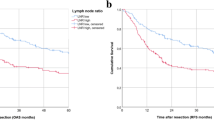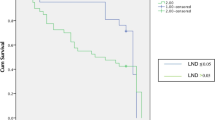Abstract
Purpose
In this study, we aimed to validate the lymph node density (LND) as an independent prognostic factor of oral squamous cell carcinoma (OSCC) and identify a combined prognostic factor including LND, predicting better performance in risk stratification.
Methods
We reviewed the clinical, pathological variables and biomarker of 95 OSCC patients who underwent surgery. LND was calculated as the ratio of positive lymph nodes to total lymph nodes removed. Principle component analysis was performed to identify a combined predictor.
Results
Multivariate analysis showed that variables independently prognostic overall survival were IMP3 (hazard ratio [HR] = 3.01, 95% confidence interval [95% CI] = 1.17–7.75, P = 0.022) in a model without LND and were IMP3 (HR = 3.64, 95% CI = 1.38–9.58, P = 0.008) and LND (HR = 0.57, 95% CI = 0.57–1.75, P = 0.322; HR = 2.45, 95% CI = 1.20–4.97, P = 0.013) in a model with LND. The risk stratification using the combined prognostic factor was more significant (P = 0.00117) than the conventional staging system and biomarker.
Conclusions
The LND was shown to be an independent prognostic factor in OSCC, and a combined factor including LND may be used for risk stratification of OSCC patients, which displayed the best performance.




Similar content being viewed by others
References
Aprill C, Dwyer A, Bogduk N (1990) Cervical zygapophyseal joint pain patterns II: a clinical evaluation. Spine (Phila Pa 1976) 15:458–461
Berger AC, Fierro M, Kairys JC, Berd D, Sato T, Andrel J, Hyslop T, Mastrangelo MJ (2011) Lymph node ratio is an important and independent prognostic factor for patients with stage III melanoma. J Surg Oncol. doi:10.1002/jso.22051
Bernier J, Domenge C, Ozsahin M, Matuszewska K, Lefebvre JL, Greiner RH, Giralt J, Maingon P, Rolland F, Bolla M, Cognetti F, Bourhis J, Kirkpatrick A, van Glabbeke M (2004) Postoperative irradiation with or without concomitant chemotherapy for locally advanced head and neck cancer. N Engl J Med 350:1945–1952. doi:10.1056/NEJMoa032641
Bernier J, Cooper JS, Pajak TF, van Glabbeke M, Bourhis J, Forastiere A, Ozsahin EM, Jacobs JR, Jassem J, Ang KK, Lefebvre JL (2005) Defining risk levels in locally advanced head and neck cancers: a comparative analysis of concurrent postoperative radiation plus chemotherapy trials of the EORTC (#22931) and RTOG (# 9501). Head Neck 27:843–850. doi:10.1002/hed.20279
Cooper JS, Pajak TF, Forastiere AA, Jacobs J, Campbell BH, Saxman SB, Kish JA, Kim HE, Cmelak AJ, Rotman M, Machtay M, Ensley JF, Chao KS, Schultz CJ, Lee N, Fu KK (2004) Postoperative concurrent radiotherapy and chemotherapy for high-risk squamous-cell carcinoma of the head and neck. N Engl J Med 350:1937–1944. doi:10.1056/NEJMoa032646
Ebrahimi A, Clark JR, Zhang WJ, Elliott MS, Gao K, Milross CG, Shannon KF (2011) Lymph node ratio as an independent prognostic factor in oral squamous cell carcinoma. Head Neck 33:1245–1251. doi:10.1002/hed.21600
Fukunaga K (1990) Introduction to statistical pattern recognition. Academic Press, Boston
Gavilan J, Prim MP, De Diego JI, Hardisson D, Pozuelo A (2000) Postoperative radiotherapy in patients with positive nodes after functional neck dissection. Ann Otol Rhinol Laryngol 109:844–848
Gil Z, Carlson DL, Boyle JO, Kraus DH, Shah JP, Shaha AR, Singh B, Wong RJ, Patel SG (2009) Lymph node density is a significant predictor of outcome in patients with oral cancer. Cancer 115:5700–5710. doi:10.1002/cncr.24631
Herr HW (2003) Superiority of ratio based lymph node staging for bladder cancer. J Urol 169:943–945. doi:10.1097/01.ju.0000032474.22093.06
Herr HW (2007) The concept of lymph node density–is it ready for clinical practice? J Urol 177:1273–1275; discussion 1275–1276. doi:10.1016/j.juro.2006.11.094
Kassouf W, Leibovici D, Munsell MF, Dinney CP, Grossman HB, Kamat AM (2006) Evaluation of the relevance of lymph node density in a contemporary series of patients undergoing radical cystectomy. J Urol 176:53–57; discussion 57. doi:10.1016/S0022-5347(06)00510-6
Kassouf W, Agarwal PK, Herr HW, Munsell MF, Spiess PE, Brown GA, Pisters L, Grossman HB, Dinney CP, Kamat AM (2008) Lymph node density is superior to TNM nodal status in predicting disease-specific survival after radical cystectomy for bladder cancer: analysis of pooled data from MDACC and MSKCC. J Clin Oncol 26:121–126. doi:10.1200/JCO.2007.12.9247
Kim SY, Nam SY, Choi SH, Cho KJ, Roh JL (2011) Prognostic value of lymph node density in node-positive patients with oral squamous cell carcinoma. Ann Surg Oncol 18:2310–2317. doi:10.1245/s10434-011-1614-6
Konety BR, Joslyn SA, O’Donnell MA (2003) Extent of pelvic lymphadenectomy and its impact on outcome in patients diagnosed with bladder cancer: analysis of data from the Surveillance, Epidemiology and End Results Program data base. J Urol 169:946–950. doi:10.1097/01.ju.0000052721.61645.a3
Li S, Cha J, Kim J, Kim KY, Kim HJ, Nam W, Cha IH (2011) Insulin-like growth factor II mRNA-binding protein 3: a novel prognostic biomarker for oral squamous cell carcinoma. Head Neck 33:368–374. doi:10.1002/hed.21457
Margel D, Harel A, Yossepowitch O, Baniel J (2009) A novel algorithm to improve pathologic stage prediction of clinically organ-confined muscle-invasive bladder cancer. Cancer 115:1459–1464. doi:10.1002/cncr.24138
Ooki A, Yamashita K, Kobayashi N, Katada N, Sakuramoto S, Kikuchi S, Watanabe M (2007) Lymph node metastasis density and growth pattern as independent prognostic factors in advanced esophageal squamous cell carcinoma. World J Surg 31:2184–2191. doi:10.1007/s00268-007-9198-9
Parsons JT, Mendenhall WM, Stringer SP, Cassisi NJ, Million RR (1997) An analysis of factors influencing the outcome of postoperative irradiation for squamous cell carcinoma of the oral cavity. Int J Radiat Oncol Biol Phys 39:137–148
Rudoltz MS, Benammar A, Mohiuddin M (1995) Does pathologic node status affect local control in patients with carcinoma of the head and neck treated with radical surgery and postoperative radiotherapy? Int J Radiat Oncol Biol Phys 31:503–508
Sanderson RJ, Ironside JA (2002) Squamous cell carcinomas of the head and neck. BMJ 325:822–827
Shah JP (1990) Patterns of cervical lymph node metastasis from squamous carcinomas of the upper aerodigestive tract. Am J Surg 160:405–409
Shingaki S, Takada M, Sasai K, Bibi R, Kobayashi T, Nomura T, Saito C (2003) Impact of lymph node metastasis on the pattern of failure and survival in oral carcinomas. Am J Surg 185:278–284
Shrime MG, Bachar G, Lea J, Volling C, Ma C, Gullane PJ, Gilbert RW, Irish JC, Brown DH, Goldstein DP (2009a) Nodal ratio as an independent predictor of survival in squamous cell carcinoma of the oral cavity. Head Neck 31:1482–1488. doi:10.1002/hed.21114
Shrime MG, Ma C, Gullane PJ, Gilbert RW, Irish JC, Brown DH, Goldstein DP (2009b) Impact of nodal ratio on survival in squamous cell carcinoma of the oral cavity. Head Neck 31:1129–1136. doi:10.1002/hed.21073
Stein JP, Cai J, Groshen S, Skinner DG (2003) Risk factors for patients with pelvic lymph node metastases following radical cystectomy with en bloc pelvic lymphadenectomy: concept of lymph node density. J Urol 170:35–41. doi:10.1097/01.ju.0000072422.69286.0e
Acknowledgments
This work was supported by Priority Research Centers Program through the National Research Foundation of Korea (NRF) funded by the Ministry of Education, Science and Technology (2011-0031396).
Conflict of interest
The authors declare that they have no conflict of interest.
Author information
Authors and Affiliations
Corresponding author
Rights and permissions
About this article
Cite this article
Kim, KY., Cha, IH. Risk stratification of oral cancer patients using a combined prognostic factor including lymph node density and biomarker. J Cancer Res Clin Oncol 138, 483–490 (2012). https://doi.org/10.1007/s00432-011-1129-3
Received:
Accepted:
Published:
Issue Date:
DOI: https://doi.org/10.1007/s00432-011-1129-3




